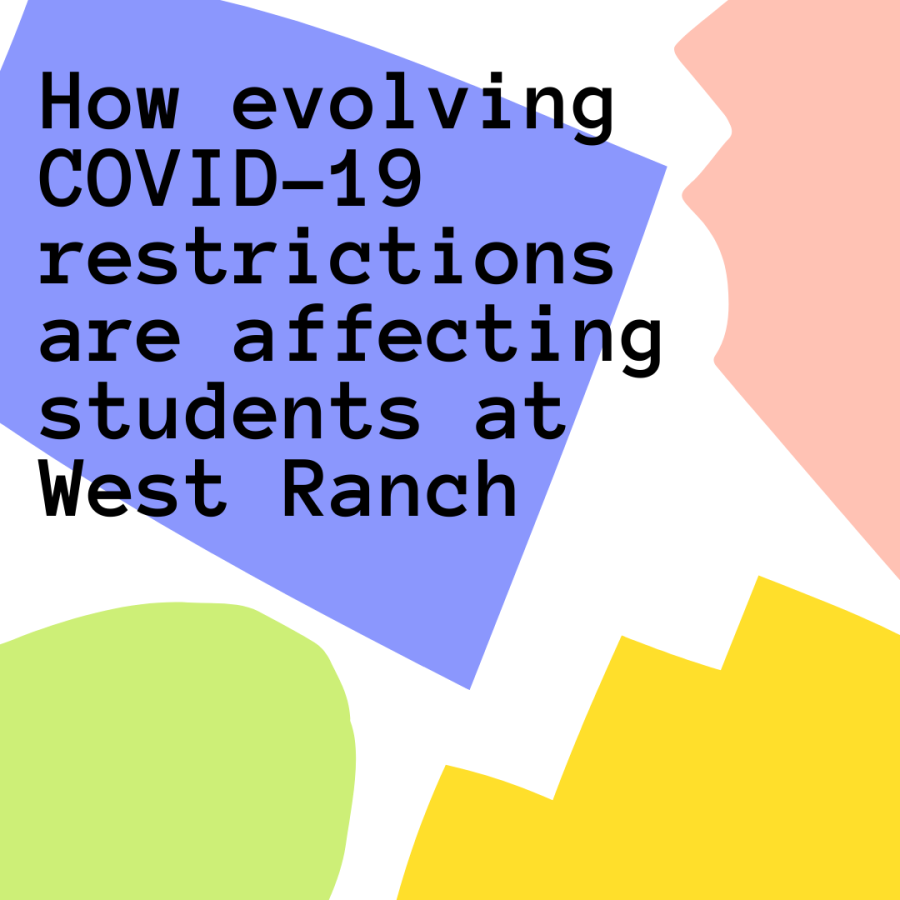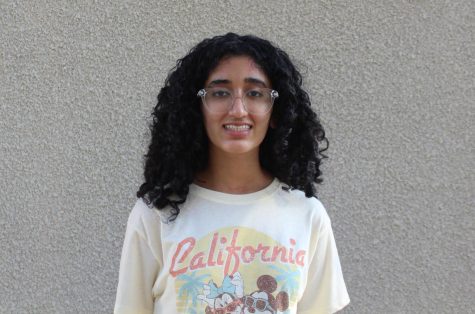How evolving COVID-19 restrictions are affecting students at West Ranch
October 15, 2021
Since the new school year kicked off here at West Ranch, all classes have returned to in-person learning, and students are back on campus after almost two years in distance learning. Although it has excited many students and staff to return to some degree of normalcy, in-person learning has presented some challenges. In order to ensure the safety of all students and staff members on campus, many COVID protocols have been strictly set in place. These new protocols have had an impact on the education and learning process for students, as well as the way that teachers teach their students.
One of the first big changes that students encounter before they enter campus are CrisisGo checks. These checks have become a necessity due to the pandemic, and all students need to complete them in order to enter the campus. However, the daily scans often create long lines of students outside school, all waiting to get checked in.
Danielle Sur, a junior, and a former member of the swim and volleyball teams at West Ranch, discussed these daily checks in an interview with the Paw Print. “It’s a process you have to endure, [along with] everyone at the gate, too. There’s often a bottleneck [of students], and it’s so chaotic… Nowadays that everyone has to be checked in, it takes more effort. I have respect for anyone who’s standing there, going through every single person, and every single time, not everyone’s going to have [their CrisisGo checks] ready.”
Sur detailed the impact that COVID-19 protocols have had on the sports she plays. “In swim, you can’t put on your mask, but after a race, you can get your mask, which is in a Ziploc, and you would swim to the other side and put it on. In volleyball, you just don’t shake hands or high-five other people on the other team anymore. You just wave at them and then back off and play the game.”
Nevertheless, learning in-person has been more trouble-free than distance learning for many students. “It’s so much more interactive,” Sur explained. “You can look your teacher dead in the eyes and they’ll know that you’re listening.”
“In addition to that, you can actually talk to people next to you, if that’s your preference. It’s kind of nice, so you don’t feel like you’re the only one experiencing class and experiencing learning, and handling it on your own,” Sur continued. “Last year there was a lot of self-studying, so it was difficult on a lot of people who usually work in groups.”
Distance learning was difficult for students, but it was also a challenge for many teachers. In-person learning has allowed teachers to interact with their students and get to know them individually.
Mrs. O’Dwyer, an English 9 and ERWC teacher, explained, “I love in-person teaching! I’m able to see all my students. I can do group work and I can see hands being raised. I can get to know more about my students and interact with them.”
As students are adjusting to in-person learning, the wellness center has seen an increase in students prioritizing mental health on campus. Mrs. Phillips, the wellness center coordinator, shared, “[This year]’s been different, so students coming in during lunch and brunch are usually coming in with a group of students and there will be an Uno game that starts or a group coloring. That’s been different. There’s been more interaction, which is nice to see.”
The wellness center has been a great outlet for students who feel the pressures of having to socialize after a long year of isolation. Mrs. Phillips discussed the wellness center’s goals and approach to help kids through this transition. “We’ve been trying to focus on the strategies that students can use and take with them. That’s always been our goal, and we are trying to be more specific with that, like how we had a drum circle. We also have some groups that we’ll offer this year. We’ve started peer listeners as well, which is still in its early stages,” she explained.
The coronavirus has not only affected students, but it has also caused significant changes to the ways teachers work and interact with students within the classroom. A class that has been greatly impacted by the pandemic is choir. Ms. Peters, the choral director at West Ranch, discussed the coronavirus from a musical standpoint with the Paw Print.
Ms. Peters explained, “I have definitely embraced the technology that goes with music creation, [and] recording… We relied on it last year for our choir projects and the kids got really good at recording, mixing, editing, etc. These are all skills that could be used in a professional music career, but as more and more people are becoming ‘DIY’ engineers and composers, I think these skills are invaluable for my current music students and I’m excited to continue to build on their previous work!”
Both in-person and online learning have presented unique challenges for the choir. “It’s really hard to sing in a mask! It makes it hard to project, to see and model correct vowel shapes, and since the sound is muffled it can be hard to hear,” Ms. Peters described. “When we have days that aren’t too hot, we sometimes go outside to sing since we can spread out and remove our masks if we want to. But, that being said, we are really enjoying singing together and creating harmony.”
When asked about any additional COVID-19 restrictions in the choir classroom, Ms. Peters responded, “As of now there are not! Just like every other class, we are masked inside, optional outside. Last spring we were required to go outside to sing or play woodwind or brass instruments, so I’m enjoying not having to wheel my keyboard outside and slather on sunscreen this year just to sing!”
All in all, Ms. Peters is excited for the rest of the year teaching students in-person.
With ever-changing COVID restrictions affecting West Ranch, challenges for the new school year have arisen for both teachers and students. Safety measures have been taken to ensure limited exposure between students, and new implementations have taken place to control the spread of the virus. But even with new initiatives popping up around campus, students and staff have become creative with their teaching styles and techniques. Through the use of these varied methods of classroom management, Wildcats have been able kick off the in-person school year, eager for interaction.




